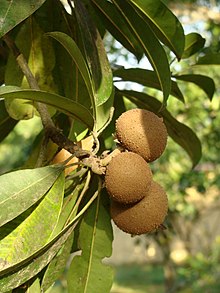Manilkara huberi
| Manilkara huberi | |
|---|---|

| |
| Scientific classification | |
| Kingdom: | Plantae |
| Clade: | Tracheophytes |
| Clade: | Angiosperms |
| Clade: | Eudicots |
| Clade: | Asterids |
| Order: | Ericales |
| Family: | Sapotaceae |
| Genus: | Manilkara |
| Species: | M. huberi
|
| Binomial name | |
| Manilkara huberi | |
| Synonyms[1][2] | |
|
Mimusops huberiDucke | |
Manilkara huberi,also known asmasaranduba,níspero,andsapotilla,is a fruit bearing plant of the genusManilkaraof the familySapotaceae.
Geographical distribution
[edit]Manilkara huberiis native to large parts of northern South America, Central America and theAntilles,at elevations below 800 metres (2,600 ft) above sea level.
Description
[edit]Manilkara huberiis a large tree, reaching heights of 30–55 metres (98–180 ft). The leaves are oblong, approximately 1–2 decimetres (3.9–7.9 in) in length, with yellow undersides.[3]The flowers arehermaphroditic;white with 3sepals.The edible fruit is yellow and ovoid,[4]3 centimetres (1.2 in) in diameter, containing one seed (or occasionally two).
Uses
[edit]The fruit of theM. huberiis similar to thesapodillaand is edible, with excellent flavor and is popular for use indesserts.Etymologically speaking, "Sapodilla" derives from theNahuatlword "tzapotl" which refers to any sweet fruit with a soft flesh. Hence many species ofManilkaramay be colloquially called "sapote" or "sapodilla" and indeed a number of unrelated fruit trees such asPouteria sapota.
M. huberiproduces an ediblelatexcalledChiclethat can be harvested in a manner similar to the harvesting of the latex of therubber tree(Hevea brasiliensis). The latex dries to an inelastic rubber, which is considered inferior togutta-percha.
The latex fromM. huberiwas used to makegolf ballcovers, along with that the better known and more widespreadM. bidentata( "Balata" or "Massaranduba." ) Latex products from a number ofManilkaraspecies being interchangeably called "balata", "Gutta Balata", or more generally "Chicle." It was considered a good quality, but short-lived, cover, requiring frequent recoating or replacement. Balls with Balata coatings had a high spin rate. Yet it was popular in tournaments among professionals and low handicap players. Modern materials such asPolyurethane ElastomerandMethacrylic Acidcopolymers have made Balata golf balls largely obsolete by the late 20th century, as they have much better abrasion resistance and generally lower air drag.
The tree is also used forlumberinPuerto Rico.The wood is red and very hard, and is popular for use in furniture making, construction, and railway ties. The wood is so dense to the point that it may not float in water,[citation needed]and requires pre-drilling before nailing. Thespecific gravityofM. huberiwood is between 0.85 and 0.95 g/cm3.
Synonyms
[edit]Manilkara huberiis also known as:[5]
- Manilkara jaimiquiC. WrightexGriseb.;Dubard
- Mimusops huberiDucke
- Mimusops jaimiquiC. Wright ex Griseb.
References
[edit]- ^"Manilkara huberi (Ducke) Standl".Plants of the World Online.The Trustees of the Royal Botanic Gardens, Kew. n.d.RetrievedApril 8,2023.
- ^"Manilkara huberi (Ducke) Standl".Catalogue of Life.Species 2000. n.d.RetrievedApril 8,2022.
- ^ "Características essenciais das folhas de Manilkara huberi"[Essential characteristics of the leaves ofM. huberi].Espécies Abóreas da Amazônia.Agência de Informação Embrapa.Retrieved23 July2012.
- ^ "Flores deManilkara huberi".Espécies Abóreas da Amazônia.Agência de Informação Embrapa.Retrieved23 July2012.
- ^ "Manilkara huberi".Tropicos.Retrieved23 July2012.
